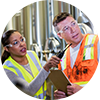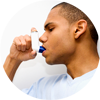Actionable Post-pandemic Strategies in Human Resources and Safety Management
Opening and agenda
0:02-0:59
Hello, everyone, and welcome to the Concentra® webinar, Actionable Post-pandemic Strategies in Human Resources and Safety Management. Today’s webinar will be presented by Dr. Cori Repp. Dr. Repp inspires continuous improvement in occupational health care through initiative and ability to inspire teams to deliver excellence. Dr. Repp is a clinical instructor, conference speaker, industry spokesperson, and both a certified medical review officer and certified medical examiner.
At the conclusion of the presentation we will have a 10-to-15-minute QandA session with Dr. Repp. You can submit your questions throughout the presentation to be answered during the QandA. Dr. Repp will answer as many questions as possible within the time allowed. A recording of the webinar and the slides will also be emailed to you after the presentation so you can view it again at your convenience.
Dr. Repp, we're ready to begin.
Introductory remarks and agenda
1:00-2:27
Welcome! Thank you for joining us today. I hope the next 30 minutes or so will help you develop your human resources and safety strategies in the post-pandemic period and truly be inspired by the lessons of our shared pandemic experience. Many positive new directions are coming out of this experience, as we will see when we look at a few of the leading trends and forecasts. Our goal today is to learn five actionable strategies for workplace health and safety in the post-pandemic period and to see how occupational health can support you in achieving positive results. Let’s take a look at our agenda….
We’re going to begin with a high-level look at the kinds of workplace changes the pandemic experience has effected. Then we will look at New Health and Safety Challenges. With that foundation firmly in place, we will then explore five action-oriented strategies to deal with those challenges. All five strategies are evidence-based and offer very tangible ways occupational health experts can come alongside you to help ensure you meet your goals in the post-pandemic period.
Finally, we will wrap up with a Q and A session. I will answer as many of your questions as time allows.
Pandemic-driven workplace reinvention: McKinsey and Company
2:30-5:10
The post-pandemic period is going to be an exciting new normal. It’s not going to be a return to our old ways, according to leading global business consultants. In the next few minutes, we’ll take a high-level look at post-pandemic trends envisioned by and for business and human resources consultants.
We’ll look at reports from McKinsey and Company, Gartner, PwC, and Deloitte. Among the areas where these consultants envision very positive post-pandemic changes are how executives and managers relate to their teams, more trust and less siloed business agility and responsiveness, especially among customer-facing teams, employees becoming more valued for their skills apart from any limitations their job role may have imposed in the past, and new harmony between employees and technology.
During the pandemic, the new, larger remote workforce really demonstrated how well employees and technology can complement each other. For example, Zoom, something that was new to many of us until the pandemic.
One report from McKinsey and Company says, “With everything disrupted, going back to the same old thing is a losing strategy. The strongest companies are reinventing themselves by embracing pandemic-driven change.” Among the positive changes McKinsey and Company sees from the pandemic ARE:
- More agile operating models (During the pandemic, businesses didn’t have the luxury of weeks or months to make decisions.)
- Organizational behaviors and practices driven by purpose; for many organizations, that purpose was survival.
- Decentralized decision making. McKinsey and Company says the pandemic brought a fresh new, trust-based connection between leaders and teams.
- Valuing employees for their skills. Location-based work, job role, and position in the company hierarchy were much less important.
- Workforces needed to be redeployed and, in some cases, retrained. This produced more energized workforces, McKinsey and Company says.
- Employees and technology are complementary. A new interdependence replaces a longstanding notion that technology is a threat to employees.
McKinsey and Company says leaders are taking advantage of “this malleable moment where new ideas are becoming the foundation of new ways of doing business.”
Pandemic-driven workplace reinvention: Gartner
5:15-6:44
Gartner, as you know, annually surveys HR leaders, assesses priorities and forecasts major trends for the coming year. Gartner believes the pandemic will lead to these nine future trends. These include:
- An increase in remote working
- Increased use of technology to track employee time and computer usage
- Growth of nonstandard work models and contingent employees
- An expanded role for employers in supporting employees’ financial, physical, and mental well-being
- Less focus on roles that group unrelated skills; development of skills leading to multiple opportunities.
- Need to address inequities in how employees are treated (humanitarian to non-humanitarian COVID approaches); rather than holding up that line, assessing the gray area and how companies can help.
- How businesses treated employees in the pandemic has impact as an “employment brand” because it reflects the culture.
- Organizational design shifts from efficiency to resilience and flexibility
- Companies will become more complex in geography and markets through mergers and acquisitions.
Pandemic-driven workplace reinvention: PwC
6:45-8:09
PwC hosted a webinar for 800 international companies. The overriding priority for most of these companies was support for new hybrid approaches to work that combine various combinations of in-person and remote work. Flexible work will become a permanent fixture, PwC says, creating a talent pool that is location-independent.
Another major trend is upskilling workers so they can flexibly be called upon to do the work that needs to be done, especially when emergencies arise. For many companies, skill gaps have been a fact of life for a while. The pandemic has made them more visible.
Another finding is that business leaders must find ways to leverage what employees learned about work in the first year of the pandemic and to develop greater empathy. This will involve listening to employees and being open to what their varied experiences may suggest for increasing operational effectiveness.
A final point I will mention is that PwC emphasized the primacy of workforce health and safety – not only related to the compliance differences between jurisdictions – a need occupational health is well-positioned to address. But, also, the need to re-acclimate employees to the workplace and to ensure they feel safe in coming back.
Pandemic-driven workplace reinvention: Deloitte
8:21-11:22
Deloitte, even more than the others, speaks to the wisdom of listening to employees: During the pandemic, what were their coping mechanisms? What brought them success? Employees’ pandemic experiences were not uniform and so rolling out best practices won’t work.
Deloitte speaks strongly of a new human-centric or employee-centric focus to work.
Some of the specifics Deloitte highlights are:
- Integrating well-being into the design of work. A Deloitte survey found that three prevailing values for workforces going forward were well-being, belonging, and ethics. Well-being and belonging fit under the umbrella of working with purpose and can be seen as an antidote to employees’ fears. Rather than prioritizing the work itself, Deloitte’s report recommends prioritizing the individual at work and designing well-being measures into work. This, Deloitte says, enhances employees’ sense of contribution and will enhance performance.
- Adapt leadership styles to employee desire for more autonomy and a desire to contribute.
- Organizational agility. Deloitte recommends planning for perpetual disruption by focusing on multiple futures.
- Finally, and this may be the most interesting point to many of you, shifting Human Resources from a role of predominantly “enforcing company policy” to re-architecting work across the enterprise. Deloitte says:
Amidst a devastating health crisis, many workers have seen a glimpse of something more. They’ve been propelled into cross-functional task teams and tiger teams to solve challenging problems to keep their organizations afloat. They’ve been empowered to make rapid decisions and react with authority to changes in the market and service delivery models. They’ve moved to working from home – sharing important moments with their families, eating meals together and witnessing the day-to-day activities of those they love most. AND Organizations have shifted their attention to better understanding and nurturing employee well-being.
Deloitte’s report on Four Future Models of Work notes: “The future of work is really about people deciding how they want to live and work in the way that they want.”
Critical trends
11:25-13:23
The consultants’ reports are interesting. I would encourage you to at least skim them. We will provide the links to these resources at the end of the presentation for you to take a look. There are many important findings but from my read of them, I would offer for your consideration four, high-level trends:
- Occupational health and safety are paramount (as PwC concluded). The pandemic instilled fear in employees and the general public. As employees come back into the workplace, it is necessary to overcome those fears and new forms of presenteeism that we will talk about later.
- A greater human-centric focus. The pandemic brought a humanizing force to work as managers expressed concern for employees and their families, the shift to survival mode added meaning to work for businesses and employees, and employees were reenergized by getting to use their skills and working more autonomously – going where there was need, independent many times of job role and location.
- Newly agile organizations – to retain their agility – will begin to prepare for perpetual disruption and individualize approaches for teams and employees, moving away from a more mechanistic set of “best practices” across the enterprise.
- An expanded role for the employer as a safety net for employee physical, mental, and emotional health (as suggested by Gartner).
The COVID-19 pandemic experience gives business organizations the opportunity to embrace a larger, more holistic definition of occupational health and safety – one in which work and wellbeing are joined to create agile, productive, and energized workforces ready to take on the next challenge.
Speaking of challenges, let’s next look at some of the new health and safety challenges you are likely to confront in the post-pandemic world.
New health and safety challenges: Long COVID
13:27-14:30
The Centers for Disease Control and Prevention (or CDC) does not yet know whether individuals who have recovered from COVID-19 can be infected again.
But here is something we do know – and it has been confirmed by the CDC. That is, COVID-19 symptoms – either the same or different symptoms experienced in the acute form of the illness – can sometimes persist for weeks or months. Initially they called it “Long COVID.” The more clinical name is Post-Acute Sequelae of SARS-CoV-2 infection, or PASC, is now being used as well. Long COVID symptoms can include one or more of the following:
- Shortness of breath
- Cough
- Pain in the chest, joints, or muscles
- Brain fog or confusion
- Fatigue
- Intermittent fever, and
- Rapid heart palpitations
Studies are underway to learn more about these symptoms. But, in the meantime, they can have a serious impact on work productivity and employer costs.
New health and safety challenges: Two kinds of presenteeism
14:31-15:26
Another employee health concern is presenteeism which, as you know, is when employees come to work even though they are ill and should be at home. There are both clinical and economic aspects. Clinical aspects if employees with long COVID symptoms come back to work prematurely. Economic aspects due the financial struggles many companies share as a result of COVID-19 closures and business impacts. Long hours, extra shifts, excessive workload, taking more risks. These may all come into play because the employee feels the pressure of job demands or is highly committed and personally engaged in work. In either case, the post-pandemic period demands a high awareness of these forms of presenteeism and medical help to identify when employee health and productivity is being impacted.
We will look at that in the next section as we discuss five top post-pandemic workforce and safety strategies where occupational health experts can provide vital support.
Occupational health-assisted strategies
15:29-16:22
We’re going to look at five possible strategies you could adopt to implement the research findings we discussed at the start about pandemic-driven changes at work. With each strategy, I will also highlight how occupational health experts can support you. These five strategies aren’t the only ones possible, of course. You may have others in mind. I would venture that any workplace strategy can benefit from occupational health support. So, if you have a strategy in mind and don’t see it here, make sure to enlist occupational health expertise. Concentra has been a leader in the occupational health space for more than 40 years. We are proficient in designing solutions for employers across all industries and helping them navigate complex challenges – new, emerging challenges – in employee health and safety.
Strategy #1: Creating a human- or employee-centric focus | Onsite clinics and vaccination programs
16:23-18:57
- As we saw, the emerging human-centric or employee-centric focus dealt with:
- Listening with empathy
- Addressing their fears and dealing with forms of presenteeism
- Answering their questions
- Helping them feel empowered
A very impactful way occupational health can support this strategy is through the establishment of an onsite clinic and a company vaccination program. Remember, consultants (specifically Gartner) said that how employers showed concern for employees and their families during the pandemic was so important and may even rise to the level of becoming an employment brand as genuine concern for employees. There is no better way than establishing an onsite clinic or other occupational health care presence to convey employer concern for employee health.
Establishing worksite-based occupational health care is not daunting as it used to be. At Concentra, for example, we have a wide range of onsite models that provide enormous benefit to the workforces they serve with only modest investments and minimal staffing – as little as a single occupational nurse or athletic trainer. The point is, onsite care has evolved, and the pandemic has shown a bright light on the wisdom of having workplace medical expertise.
Concentra clinicians are all trained in techniques to put employees at ease and understand their underlying fears or concerns. This involves listening with empathy and providing health education through the use of objective, evidence-based research. An onsite clinic or any level of onsite medical expertise is a valuable resource in the post-pandemic period.
Regarding COVID vaccination programs, they are experiencing some birthing pangs as employers struggle to acquire doses and wrestle with complex vaccine storage and handling questions. We can expect that the future will be easier as more vaccines come to market, dose access improves, and employers grow more accustomed to acquisition and handling procedures. Policymakers have talked about the possibility of COVID-19 booster shots being necessary. We don’t know yet if that will be true. Regardless, you can count on occupational health expertise for support for all your travel health and vaccination needs for employees. Occupational health experts also provide counsel on the timing and administration of the various vaccines and COVID vaccines to that employee health is not jeopardized.
Strategy #2: Flexible, hybrid, or decentralized workforces | Telemedicine and telerehab
19:00-21:42
The Society for Human Resource Management – a source that is familiar to many of you – reported on a survey of 283 large employers representing 4.4 million employees. The survey found that employers expect to have significantly more remote employees in the future compared to 2019 but still need to take fundamental actions to adapt – such as developing policies and training. Employers have seen the benefits of a larger remote workforce and hybrid work models in a more energized workforce. It also helps prepare for future emergencies by giving managers and employees experience in alternative work models.
Telemedicine visits grew substantially during the pandemic. The Centers for Disease Control and Prevention or CDC reports that telemedicine visits increased by 50 percent in the first quarter of 2020 compared to the same period in 2019. In week 13, a 154 percent increase was reported. This boost was not only due to increased interest and comfort in telemedicine but also because of regulatory waivers that helped increase telemedicine adoption. Now that we see that it can work – and how well it works – the mainstreaming of telemedicine across all businesses is well-positioned to support new, flexible work models.
Telemedicine options at Concentra include Concentra TeleMed® for injury care and many minor health and safety needs, as well as for physical therapy and all kinds of musculoskeletal injury and recovery. Because these visits can take place at the worksite or any location where employees work with internet connections, companies save productive time. This flexibility may also promote employees’ earlier reporting of injury or illness. Concentra’s model of injury care is one of early intervention. The early intervention approach received new support from evidence-based research contained in two 2020 reports from the Workers’ Compensation Insurance Rating Bureau or WCIRB. Their research found that delaying care – and not using an early intervention approach – resulted in significantly higher indemnity and medical costs, longer case duration, higher disability rates, and greater use of opioids and expensive imaging and specialty care.
As you can see, increased use of telemedicine options for medical care, injury care, and musculoskeletal health is a vital and highly beneficial strategy in the post-pandemic period.
Strategy #3: Organizational agility; prepare for continual disruptions | Pre-employment functional testing
21:45-22:59
We’ve seen in the consultants’ reports that workforces were energized when they were redeployed or provided new training to enable them to contribute to emergency business needs during the pandemic, even serving needs outside their assigned job role. This may be energizing to the psyche, but it risks injury to the body UNLESS managers and supervisors have a clear idea of an employee’s physical capability. Functional testing at the pre-employment phase, upon return to work after an absence, or at any time you find it useful, provides insight into physical capability through a well-designed assessment format. This format brings together relevant objective measures of specific job tasks. There is no need to guess if an employee can handle a job task you need to be done. Objective science tells you.
Functional testing is provided by occupational health experts because they understand your business, your industry, and the work that needs to get done. No other medical expert has that precise knowledge and proximity to the work you do, day in and day out. Not only does functional testing help prevent injury but also now, in the post-pandemic period, it can help your business be better prepared in emergency redeployments of your workforce.
Strategy #4: HR re-architecting work | Individualizing histories, physicals
23:01-24:53
The Deloitte report I mentioned earlier tells business leaders they “should invest in understanding their workers’ needs – now and projecting beyond COVID-19. If not, leaders risk allowing productivity and morale to wane.” Business leaders who take this advice will be coming to you in Human Resources for leadership in doing what Deloitte calls “re-architecting work across the enterprise.”
Part of what that means is that you will need an in-depth understanding of not just the capabilities of large subgroups – by job or location – within your workforce. You will also need an understanding of individual employees – their likes and dislikes, their goals, what motivates them, their work ethic, and any other areas that will benefit by their employer’s empathetic understanding. How will you get that knowledge?
Disclosure of personal health information is not what we’re talking about here. Instead, we’re talking about the skill of individualization and, from an HR perspective, taking each employee as a standalone case on his or her own merits. For example, when the occupational health clinician examines a material handler, the exam is based on industry performance of all material handlers. There may be some knowledge that’s in the background, but mostly it’s about tactfully and strategically asking questions of that person in the exam room to elicit information that’s relevant to the exam and understanding their health issues. A special skill that occupational health experts can help you with, for instance, is that we have learned that very personal factors can either promote recovery or hinder the pace of recovery in work injury cases. This is called a biopsychosocial approach to occupational medicine, and we will talk about that next.
Strategy #5: New management models of empathy, listening | Biopsychosocial approach, drug testing
24:55-29:22
In occupational health care, at Concentra, we take a biopsychosocial approach to care because there are elements of empathy and understanding involved. This is an occupational health approach that can be a useful model for managers who wish to exercise greater use of empathy in leading teams in the post-pandemic period.
Let’s consider a biopsychosocial approach in injury care, for example. It addresses the psychological and social factors that motivate an employee to participate in the treatment plan. Those factors can include feelings of social isolation, fear of job loss, loss of income, and even anger or hostility toward an employer. Eliminating these barriers can promote recovery and avoidance of unnecessary disability, lost time and productivity, and total case costs. You can see how such a multi-layered approach would be useful in the aftermath of the COVID-19 pandemic, given all the psychological and social pressures felt by employees.
Regarding behavioral health, this is a newer area for occupational health specialists. The foundation is one of compassion, emotional intelligence, and strong communication between clinician and employee or employer and employee. We have an article on Concentra’s website that talks about behavioral health issues and provides very useful tips for things your managers can do at minimal or no cost. The article is, “Better Workplace Mental Health Through Approaches to Anxiety.” Anxiety was an almost universal experience of the pandemic. The perfect storm of multiple pressures coming together from all sides may bring about major changes in the attitudes or behaviors of some employees when they return to work. Dealing with anxieties may take weeks or months so be ready to exercise compassion because it takes time. Human resources is well positioned to help managers with expectations and leading employees who return still feeling the effects of anxieties. The article I mentioned provides the names of books and resources that can help.
Finally, occupational health care provides drug testing. It may or may not surprise you to learn that substance abuse has emerged as a genuine threat after business re-openings and going forward. I presented a webinar in August 2020 called, “Mitigating Substance Misuse During the COVID-19 Pandemic” that I think you will find really useful. It’s on Concentra’s website in the webinar section of the Resource Center. Three tips for occupational health support with substance abuse testing are, first, to reach out and talk with us about a customized program. Second, encourage self-care. Remember how consultants said the feeling of an employer truly caring about the welfare of employees was so strong as to emerge as an “employment brand.” Employees want employers who genuinely care about them. Third, reinvigorate (or start) an employee assistance program, so that those individuals who need to reach out have a resource.
Also, I would take you back to what I said earlier. Having an employer-sponsored onsite clinic is the most powerful daily reminder to your employees that their employer cares about them, and that realization will go far to motivate your employees’ loyalty and productivity in the post-pandemic period.
The next slide gives you the resources I talked about – the consultants’ reports and Concentra articles. I’ve also included the webinar I presented about drug testing, as well as some other Concentra webinars related to COVID-19.
With that, that concludes our webinar. Thank you once again for attending our webinar, and I will open our remaining time to any questions you may have.





